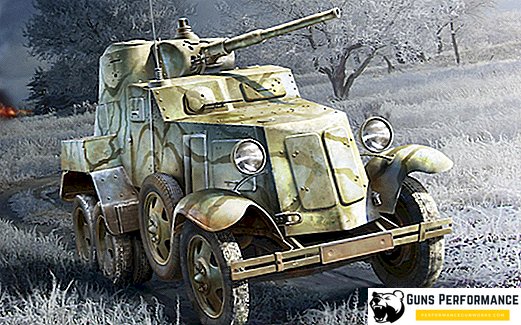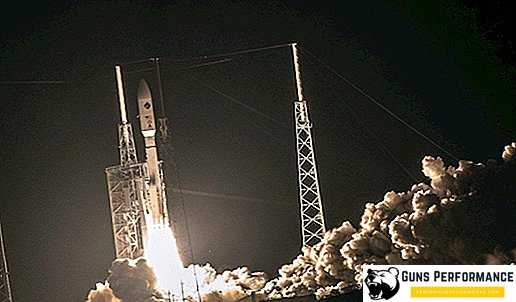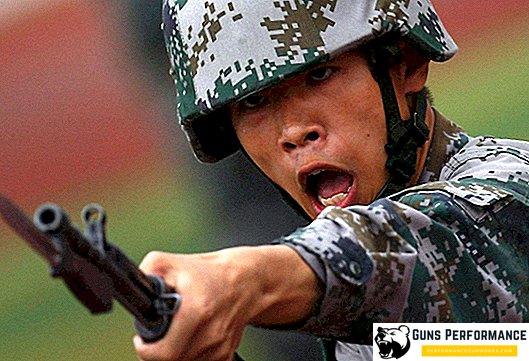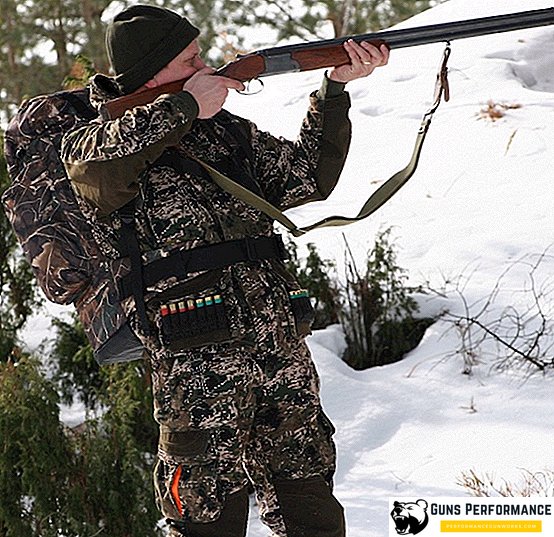Tavor tar 21 - new Israeli automatic rifle, which has a 5.56 mm caliber. The assault rifle was created according to the "bullpup" scheme. Unlike many other samples that were created by IMI (Jericho, Galil), the tavor tar 21 is not a converted or upgraded version of another weapon. The Israeli Defense Industry has created a completely new design.
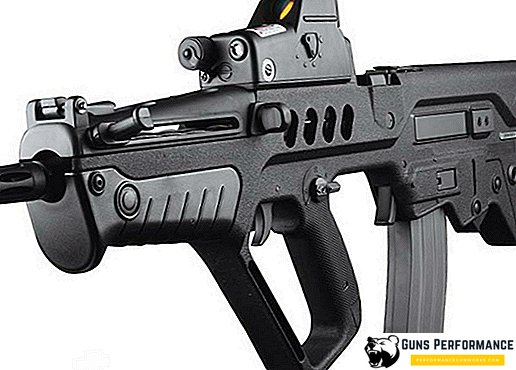
In addition, "Tavor" was developed by engineers on their own initiative, without a contract signed in advance with the Israel Defense Forces. The army did not need to acquire a new weapon, because it was completely satisfied with the various options for the M16 - from sniper options to carbine. It should also be noted that M16 rifles are bought at reduced prices from the FMS (financial assistance to Israel from America), while the cost of one Tavor is about $ 1,000.
History of creation
The IDF command, after completing a review of world weapons, in 1993 decided to replace the outdated Galil assault rifle with an M16 assault rifle. But Israel Military Industries, a few months before that, began to proactively work on a new weapon, designing it for patron 5.56 × 45 mm. As a result, the project was considered promising and it was decided to continue work, despite the purchase of automata from America.

The development of IMI was first presented to the public under the designation "M-203" in the mid-1990s. Later, in order to avoid confusion with the grenade launcher, which had the same name, the machine gun was renamed AAR (progressive assault rifle). After some time, the weapon received the final name Tavor tar 21.
At the beginning of the 2000s, military tests of the TAR-21 took place. Identified certain shortcomings of the machine:
- bad sight;
- unreliability;
- in the position of lying the difficulty of changing the store;
- thick pistol grip.
In 2004, a modified version of the Tavor tar 21 entered into service with the Israeli security forces.

First prototype
The first conceptual prototype of Tavor tar 21 was created not by professional designers, but by two civilian designers from Formtech, who had absolutely no experience with weapons. However, most of the details of the prototype embodied in the final product. To reduce the price of weapons, had to abandon:
- complex support bipods;
- expensive butt rather complex configuration.
Tavor, like other modern designs, was developed using CAD software.
The overall management of the final project was carried out by Moti Rosen, a reserve colonel and deputy general director of the Institute of Metrology. The engineers Amnon Shiloni, Boron Erez and Zalman Shevs also took part in the work.

Current status
The Israel Defense Forces never pledged to purchase Tavor, but the entire development process was carried out in close cooperation with the IMI and the IDF. In particular, the AOI has developed a list of technical requirements for the new product. It was originally planned to finish development within 3 years, in 1995 the prototype was ready. In 1996, prototypes were tested in various infantry units.
For 1999, the main problem of Tavor was the quality of production of serial samples. Often there were failures, but later all the "childhood diseases" were eliminated.
In 2003 there were rumors that with the reduction of the military budget, the purchase of Tavor rifles would be frozen. Military purchases wanted to be reduced by more than 1.1 billion dollars. However, Tavor saved a contract to sell Israeli-made Tavor rifles to the Indian army. The contract was estimated at hundreds of millions of dollars.

Design
Assault rifle "Tavor" is made according to the well-known "bullpup" scheme. Thanks to the linear scheme, the rifle was able to provide high accuracy of shooting, but this approach has a significant drawback - aiming devices should be placed a little higher. Automatics is based on the removal of powder gases from the barrel by means of the gas outlet located above the barrel and hidden by the body.
Gas piston, which is rigidly fixed to the bolt carrier has a long stroke. Barrel for 7 lugs locked by turning the bolt. On both sides of the receiver there are windows for ejection of spent cartridges. Cuts under the charging handle are made on both sides.
Tavor tar 21 - assault rifle caliber 5.56 mm, can use different types of ammunition - M885, M193 and others.
The "Tavor" case is made of high-strength polymers together with the use of light alloys (aluminum and the like).

Primary disassembly is easy to produce in the field without the use of tools. To disassemble the weapon, push out the connecting rod, which is located in the rear upper part of the butt. Then the butt plate can be tilted back and down, and the slide frame assembly can be removed outside.
The shells are thrown to the right, but the assault rifle is quite easily converted to left-sided shells. "Tavor" uses standard stores M16 (NATO standard), which is very convenient to supply.
Performance characteristics
The TTX overview is as follows:
- Caliber - 5.56 mm.
- The used cartridge is 5.56 mm NATO SS109 / M855.
- Magazine capacity - 20-30 rounds.
- Overall length - 720 mm.
- Barrel length - 460 mm.
- Weight (not equipped) - 2.8 kg.
- Weight (curb) - 3,635 kg.
- Trigger pull force is 2.5-4 kg.
- Sight - collimator + laser.
- Modes of fire - single / automatic.
- Rate of fire - 750-900 shots / min.
- The initial speed of the bullet - 890m / s.

Accessories
Since Tavor was originally created to replace the M16 family, it has a wide range of modifications as well as accessories for performing various tactical tasks:
- trunks of different lengths;
- optical / night sights;
- adapter to install a grenade launcher M203;
- muffler.
If necessary, the rifle makes it possible to fire a NATO-style rifle grenades that are worn on the barrel.

Tavor is equipped with ITL MARS collimator sight, it has a built-in laser target designator and an infrared sight, which makes the review of the combat situation more intuitive. At the same time, the "Tavor" does not have its own "metal" sight - this is a significant drawback. A weak consolation will be the fact that in case of ITL MARS failure (battery emptying or breakdown), you can use an open metal sight, which is located on the MARS body. Some types of rifles are equipped with ITL N / SEAS, an additional night-sight.
Features TAR-21
In comparative tests "Tavor" has advantages in certain indicators:
- When using the increased shock resistance.
- High functional reliability when used in extreme conditions.
- Ergonomic design that allows you to increase the user's stealth and comfort.
- Constant round-the-clock application without prior adjustment.
- Compact, accurate, and relatively short rifle with a long barrel.
- The rear center of gravity is close to the user's body, which ensures reliable aiming and holding along the front in motion.
- Bilateral, that is, the possibility of right-left-side use.
- Accurate and modern aiming system, which is attached directly to the barrel.
- Anti-corrosion coating.

TAR-21 modifications
- GTAR-21 is a version with a mount for a 40 mm grenade launcher.
- Tar-OICW is an upgraded version of the TAR-21, which includes the installation of a data line, a ballistic computer, a laser rangefinder and electronic sighting devices.
- CTAR-21 is a compact version with a reduced weight and a shortened barrel, for special operations forces.
- MTAR-21 is the most compact option.
- MTAR-21 model X95R. Equipped with a 330 mm barrel. Under the cartridge 5.45 × 39 mm.
- MTAR-21 "Zittara" - a modification of Indian production, converted under the Indian cartridge 5.56 × 30 mm.
- MTAR-21 X95 7.62 - modification chambered for 7.62 × 51 mm NATO, which increased the effective range and greater lethal effect.
- STAR-21 - sniper version with a telescopic sight and bipod.
- T.C.-21 - civilian shortened self-loading version.


